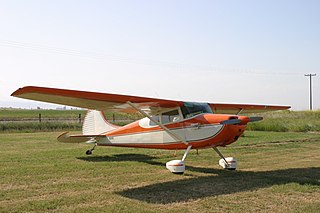
The Cessna 170 is an American light, single-engined, general aviation aircraft produced by the Cessna Aircraft Company between 1948 and 1956.

The Cessna 150 is a two-seat tricycle gear general aviation airplane that was designed for flight training, touring and personal use. In 1977, it was succeeded in production by the Cessna 152, a minor modification to the original design.

The Cessna 180 Skywagon is a four- or six-seat, fixed conventional gear general aviation airplane which was produced between 1953 and 1981. Though the design is no longer in production, many of these aircraft are still in use as personal aircraft and in utility roles such as bush flying.
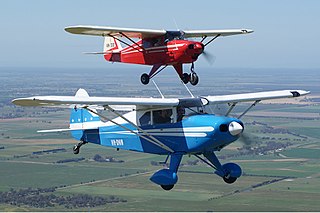
The PA-20 Pacer and PA-22 Tri-Pacer, Caribbean, and Colt are an American family of light strut-braced high-wing monoplane aircraft built by Piper Aircraft from 1949 to 1964.

The Cessna 175 Skylark is a four-seat, single-engine, high-wing airplane produced by Cessna between 1958 and 1962.
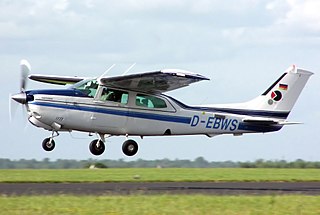
The Cessna 210 Centurion is a six-seat, high-performance, retractable-gear, single-engined, high-wing general-aviation aircraft. First flown in January 1957, it was produced by Cessna until 1986.
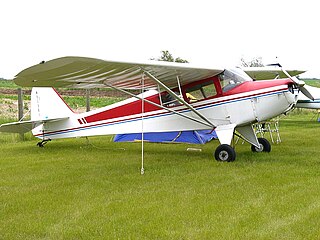
The Taylorcraft B is an American light, single-engine, high-wing general aviation monoplane, with two seats in side-by-side configuration, that was built by the Taylorcraft Aviation Corporation of Alliance, Ohio.

The Cessna 185 Skywagon is a six-seat, single-engined, general aviation light aircraft manufactured by Cessna. It first flew as a prototype in July 1960, with the first production model completed in March 1961. The Cessna 185 is a high-winged aircraft with non-retractable conventional landing gear and a tailwheel.

The Cessna 421 Golden Eagle is an American six or seven seat twin-engined light transport aircraft, developed in the 1960s by Cessna as a pressurized version of the earlier Cessna 411.

The Luscombe 8 is a series of high-wing, side-by-side-seating monoplanes with conventional landing gear, designed in 1937 and built by Luscombe Aircraft.

The Cessna Airmaster, is a family of single-engined aircraft manufactured by the Cessna Aircraft Company. The Airmaster played an important role in the revitalization of Cessna in the 1930s after the crash of the aviation industry during the Great Depression.

The Aeronca Model 7 Champion, commonly known as the "Champ", or "Airknocker", is a single-engine light airplane with a high wing, generally configured with fixed conventional landing gear and tandem seating for two occupants.

The Fisher Dakota Hawk is a Canadian side-by-side two-seat, conventional landing gear, single-engined, high-wing monoplane kit aircraft designed for construction by amateur builders.

The Stits SA-3A Playboy is a single seat, strut-braced low-wing monoplane that was designed by Ray Stits for amateur construction. The aircraft was designed and the prototype was completed in a three-month period during 1952. The design went on to become one of the most influential in the post-war boom in aircraft homebuilding.
The Scott Ol' Ironsides is an early homebuilt aircraft using wood construction with stressed fiberglass panel construction.
The O'Neill Model J Magnum, also called the Magnum Jake and the Magnum Pickup, is a homebuilt aircraft design for bush flying operations similar to the de Havilland Beaver.
The Anglin J6 Karatoo is an Australian ultralight and light-sport aircraft that was designed by Jesse Anglin and introduced in 1982. Over the years the J6 Karatoo has been produced by several different manufacturers, including Amax Engineering of Donvale, Victoria, Skyway Aircraft and is currently built by Serenity Aviation of Australia. The aircraft is supplied as plans or as a kit for amateur construction.
The Acrolite is a family of Canadian amateur-built aircraft, designed by Ron Wilson and produced by Acrolite Aircraft of Kakabeka Falls, Ontario, in the form of plans for amateur construction.
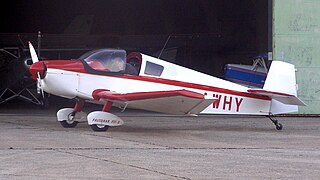
The Falconar F11 Sporty is a Canadian amateur-built aircraft, that was designed by Chris Falconar and produced by Falconar Avia. Falconar supplied it as a kit or as plans for amateur construction. Today both the F11A and E models are available as plans from Manna Aviation.
The Bounsall Super Prospector is an American STOL homebuilt aircraft that was designed and produced by Bounsall Aircraft of Mesquite, Nevada, introduced in 1990s. When it was available the aircraft was supplied as a kit or in the form of plans for amateur construction.





















